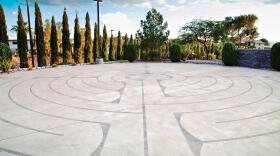Artist Michael Ogilvie, who has administered public art programs for the city of Las Vegas and, most recently, Clark County, is leaving town after a string of successes that include the county’s “Centered” project — grabby artworks enlivening medians on local roadways — and last month’s installation of Wayne Littlejohn's “Dream Machine” sculpture in Siegfried & Roy Park (above). He’ll be doing similar work in San Jose, California. So we picked his brain one last time.
What changes, for better or worse, have you observed in the state of public art here?
There is no “worse” unless you reach back before the 1970s, when public art was virtually nonexistent in Las Vegas. Public art has come on in a big way in this town, and part of that is because we have this vast landscape, a giant earth canvas, whose inhabitants yearn for more than asphalt and concrete.
One of the challenges in public art here has simply been to defend it and educate the public. Thankfully, it is not too hard to do when you have hundreds of talented artists who call this area home and who are creating superior visual art. When the art is strong, it stimulates public imagination. Imagination leads to innovation. Innovation leads to a better world. So “better” is the road Las Vegas is on now in regards to public art, and hopefully it stays that way.
What’s needed to get public art to the next level?
It needs to take on big problems. In Philadelphia, they use their mural program to help reduce recidivism in prisons, and it is working. In Seattle, artists like Buster Simpson are creating art for less toxic sanitation processes. And here, Sush Machida created art to ease the pain of abandonment for children going into Child Haven. Public art, like any good government service, should solve problems and help make life better.
Also, Las Vegas needs to continue to employ local artists. If you employ them, they will stay (and more will come). If Las Vegas wants to take its public art to the next level, it needs to keep the ingenious artists living here engaged and employed. This will grow the creative economy, and the larger the creative economy becomes, the greater its impact. Las Vegas can do this if it can retain and attract talent. But it won’t be able to do it with just public art. The entire art infrastructure (museums, galleries, collectors) needs to be in place for public art to get to the next level.
What would be your dream public art project in Las Vegas?
Developing an artwork that doubles as a water generator/harvester. It can be done, even in regions as arid as this. An artist-designed water generator/harvester that can nourish millions of people is where my imagination goes. Water is our biggest problem. Let’s fix it with public art. Or at the very least get the dialogue going.








